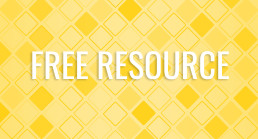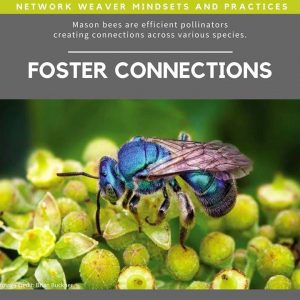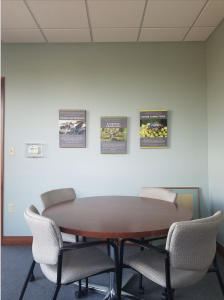Weaving Together a World Without Violence
[ap_spacing spacing_height="15px"]
The Medicine Cards
Companion to the healing cookbook, the medicine card deck is arranged into five suits: invocations, principles, ingredients, recipes and wild card.
These cards are designed to invoke the senses as well as the intellect, through visual representation, inquiry, and invitations to practice physical movement; they challenge the user to engage in the world differently.
Click Here to Download
[ap_spacing spacing_height="30px"]
The Healing Cookbook
Companion to the medicine cards, the healing cookbook provides more detailed information about the principles, ingredients and recipes and how they might be used.
The cookbook also links these elements to the learnings and tools put forth by our mentors, partners and wisdom keepers in the field.
Click Here to Download
[ap_spacing spacing_height="30px"]
These resources were co-created by sixteen California-based network leaders who participated in the Network Weaver Learning Lab, which was an 18-month program created through a partnership between Change Elemental and CompassPoint Nonprofit Services. Find the original posts for these resources at these sites:
https://changeelemental.org/resources/invocations-principles-ingredients-and-recipes-for-nourishing-social-justice-practitioners-and-networks/
https://www.compasspoint.org/weaving-together-world-without-violence
Learning to Breathe in the Network Era
The networked workplace is the new reality. It’s always on and globally connected. This is where all organizations are going, at different speeds and in a variety of ways. Some won’t make it. In many organizations the outside world is better connected than inside the workplace. This makes it difficult to connect at the boundaries, which is where we have the best opportunities for serendipity and potential innovation.
At the edge of the organization, where there are few rules; everything is a blur. It may even be chaotic. But opportunities are found in chaos. Value emerges from forays into the chaos. In such a changing environment, failure has to be tolerated. Nothing is guaranteed other than the fact that not playing here puts any organization at a significant disadvantage.
When dealing with work problems we can categorize the response as either known or new. Known problems require access to the right information to solve them. This information can be mapped, and frameworks such as knowledge management can help us map it. We can also create tools to do work and not have to learn all the background knowledge in order to accomplish a known task. New problems need tacit knowledge to solve them. The system handles the routine stuff and people, usually working together, deal with the exceptions. As these exceptions get addressed, some or all of the solution can get automated, and so the process evolves. Exception-handling is becoming the primary work for people in the networked workplace.
Complex and new problems cannot be solved using standard methods. Customized work is the realm of people, not machines or software. People are the best interface with complexity but they need to be connected and not work in isolation. This increases the need for more cooperation (freely sharing without any specific objective) as the primary long-term activity, and collaboration (working together on a given problem) for short-term specific projects.
Another challenge for organizations is getting people to realize that what they know has diminishing value. How to solve problems together is becoming the real business imperative. Sharing and using knowledge is where business value lies. With computer systems that can handle more and more of our known knowledge, the network era worker has to move to the complex and chaotic edge of the organization to do the valued work of exception handling.

Three major changes are needed for the network era workplace.
First, power must be distributed. Distributed power enables faster reaction time so those closest to the situation can take action. In complex situations there is no time to write a detailed assessment. Those best able to address the situation have marinated in it for some time. They couldn’t sufficiently explain it to someone removed from the problem if they wanted to anyway. Shared power breathes trust into the workplace.
“One of the big challenges for companies is that unlike information or data flows, knowledge does not flow easily – as it relies on long-term trust-based relationships.” – John Hagel.
Second, transparency must become the norm. Transparency ensures there is an understanding of what everyone is doing. It means narrating work and taking ownership of mistakes. Transparency helps the organization learn from mistakes. Of course this is very difficult for any command and control organization, with its published organization chart and sacrosanct job titles, to embrace. Transparency is a breath of fresh air that cleans the cobwebs from the hierarchy.
Power-sharing and transparency enable work to move out to the edges and away from the comfortable, merely complicated work that has been the corporate mainstay for decades but is now getting automated. There’s little comfortable, stable work left to do inside the organization. But there will always be complex problems that cannot be solved through automation. These will require active, engaged, and constantly learning professionals.
Third, everyone in the organization must take control of their learning. It cannot be left to the Training Department. Continuous learning is now a critical workplace skill. Work is learning, and learning is the work. This is an ongoing process of moving knowledge from the edge (social networks) to the core (work teams) and back out to the edges. It is how knowledge can be pulled on a daily basis. Connecting the edge to the core is a major challenge for organizations. It means connecting emergent practices and cooperative behaviours with collaborative project-based work. Part of the solution is more open management frameworks but another part is “edge-like” individual skills and aptitudes. Personal Knowledge Mastery covers the latter. It is a continual process of seeking from the edge (networks), filtering through communities of practice, sense-making at the core (work teams), and sharing back out to our communities and networks. Once habituated, it’s like breathing – in and out, regularly.
Originally published at Jarche.com
The Importance of Learning in Networks
We are seeing a shift in the social transformation space from evaluation to learning and support for change. Evaluation has too often been a judgment-based, funder driven approach to determining whether progress has taken place that tends to penalize risk-taking and innovation and focus mindlessly on outcomes even when it’s not clear what the solutions are.
System-shifting networks are sets of organizations, individuals and funders who are committed to innovating, experimenting, collaborating and learning to shift to healthier systems. In such networks, participants need a system of support that enables learning and change to happen on individual, organizational, collaborative project, network, culture and system levels: it’s what is called fractal change. *
*A fractal is a phenomenon in nature or mathematics that manifests as a repeating or self-similar pattern at every scale.
From my experience, I’ve seen change and learning are most likely to happen in collaborative projects and when scaffolding for learning is in place. So if we want to track anything as our networks go forward, it would be in these two places.
[ap_spacing spacing_height="10px"]
A. The scaffolding for learning consists of the following:
- Trained catalysts: Facilitators who enable people in collaborative projects to pick up network culture/values, skills and practices more rapidly (especially equity) and help projects be more successful; learning weavers who capture what is learned and share with the network so all benefit from learning in the project. [ap_spacing spacing_height="10px"]
- Innovation funds that not only support these projects but bring together funded projects in Communities of Practice where participants learn how to learn more explicitly. [ap_spacing spacing_height="10px"]
- Just-in-time tracking (for example surveys on things like network values and network leadership) that participants use to see where they (as individuals, groups, networks, etc) are having challenges in shifting to a network way. Having quantitative measures enables the individual, group or network to quickly determine strengths and challenges and then develop strategies to shift those challenges and later see if those strategies worked. We have developed surveys on network values, network leadership, collaboration skills and whole network assessments, see resources. [ap_spacing spacing_height="10px"]
- Cross-network learning and sharing sessions: networks (or more usually projects) reach out to learn from other networks. This learning is shared with the field. [ap_spacing spacing_height="10px"]
- A communications system that makes it easy to share learning within projects, among projects, with the network and with other networks. [ap_spacing spacing_height="15px"]
B. Collaborative projects are where people collaboratively work on shifting their own values and behavior in a supportive, nurturing environment and at the same time are continually trying new approaches and learning from what they do.
We could greatly benefit by focusing on these small groups as the petri dish of transformation: introducing different practices and discovering which have the potential for both personal and network transformation.
The trick to scaling change is to support the change that happens in collaborative projects to ripple out throughout the network and on to networks of networks.
So what would be helpful is for those of you who are network evaluators to watch and record and reflect back the whole network:
- Is change happening in projects? When is it most successful? What are participants doing that seems to accelerate individual and collaborative change? [ap_spacing spacing_height="10px"]
- What scaffolding is in place and functioning well? Where is work needed? How are these pieces of the scaffolding supporting learning? What aspects seems to be the most effective is supporting learning? [ap_spacing spacing_height="10px"]
- Is learning spreading from projects to network? From projects and networks to networks of networks? How is it spreading? What accelerates spreading? [ap_spacing spacing_height="10px"]
- Is learning being applied to future projects? Examples? Can we follow the path? What enables people to use other people’s/project’s learning?[ap_spacing spacing_height="15px"]
Another interesting aspect of self-organizing networks (where people are involved in several collaborative projects at any one time) is the flow of innovations from one project to other projects as the participants in the original project share their innovations with their other projects. This is how zoom became the standard for most networks - early adopters like me used it with all our projects and its use spread with amazingly rapid speed. It would be really useful to see if this kind of spread of other innovations generated by projects or networks could be tracked to determine how spread could be accelerated.
I feel that learning has been grossly underdeveloped in networks. I believe that if we started spending much more of our time in learning while we are doing, transformation could occur quite quickly.
So please start experimenting and sharing back with us what you learn about learning!
Start At Yes : building resilient networks
In working with communities to build resilient networks, I’ve noticed a pattern. Those who “start at yes” – listening for the possibilities, helping others make sense of their ideas, shining the light on contributors and the community as a whole – are vital to the health and hope of a network. As I encounter the “start at yes” people in my community work, I acknowledge to them the loveliness of their approach and ask how they acquired it. So far, only one said they didn’t know – they just assumed they were born with it.
Most of the people who start at yes say they had either a role model who emulated this attribute or someone who expected it of them – often, a parent or sometimes, a boss. Their self-awareness also interests me, because they realize they are making a choice about how they show up. If one person can do this, can a whole community? Can a community collectively change its mindset? Evidence suggests it is possible – but how to begin?
I began doodling a spiral list of phrases these “start at yes” folks use. The spiral looks like this:

At a community meeting one night, we started a conversation about mindset – and how people living there talked about their town. The pattern was one of discouraging phrases and fault-finding. While no one disagreed that a change was needed, there wasn’t a clear path to what would make it possible. We started thinking aloud about what we could do to experiment. This is when the fun began. Two people in the session were active in improvisational theater – improv. Why not try improv as an approach to a collective mindset shift? Doing what improv requires: Making a deliberate connection between the mindset of starting at yes – a willingness to go with it - and playing with possibilities.
The more we talked, the more we agreed that an injection of hope and making it second nature to incorporate others’ thinking into our choices and throwing the ball back to others and trusting them to act – could have a lasting effect. If nothing else, improv would allow community members to deepen connections, play together, better understand and temporarily inhabit a “we” mindset, and grow to trust their instincts. And if something falls flat, to pick themselves up and keep moving.
Improv relies on generosity – the success of one increases the possibilities of success of all, as is the case when building community. And improv is easy to get started – low cost, fun. If you’ve never done improv, I hope that you will be curious enough to explore it. One source that offers great information is http://www.improveveryday.com/resources. Somewhere in your network of connections or in your community, there are people well-acquainted enough with improv to help get things going.
One simple starting point is to take the phrases on the spiral, above, write one each on a sticky note. Introduce a story line – something a little far-fetched, like “I hear the train may start weekly runs to our town.” Then, have participants utilize the phrase on their sticky note to build on this story line. Begin by reading the story line aloud and choosing someone to go first, and let it go. Encourage people to play – be lighthearted and to let go of performance anxiety. The point is the interplay, not a perfect production.
Down the road, I will provide an update on any changes we see as a result of our improv collective leadership experiment. We realize that it will take early adopters, effort, repeated experimentation, and building new habits of mind to maximize the improv experience. We are building a pattern of play, learning, and un-learning. Stay tuned.
Please share your insights, experiences and questions in the comments section below.
MENDING THE COMMUNITY CUP
For years in conversations in organizations, within advocacy groups, and social change initiatives, I have heard variations of these themes:
- “We know we have to move beyond top-down approaches – how do we get more bottom up input and ideas?”
- “How do we get more diverse voices to the table? We need the input of the grassroots in the room.”
- “How do you engage the people on the ground with lived experience?”
Notice the images within these statements: they imply a vertical hierarchy where there is a top and bottom (e.g., grassroots, on the ground). Hierarchical thinking is so ingrained in our mindsets and how our organizations are set up that it can be hard to imagine another way. Yet, these vertical images are a conceptual overlay on reality. In Donella Meadows’ landmark article Leverage Points: Places to Intervene in System, she described 12 ways to intervene in a system, in increasing order of effectiveness, starting with #12 as the least. Near the top, #2 on her list is: The mindset or paradigm out of which the system arises. She writes: “The shared idea in the minds of society, the great big unstated assumptions—un-stated because unnecessary to state; everyone already knows them—constitute that society’s paradigm, or deepest set of beliefs about how the world works.” #1 is: The power to transcend paradigms.
What happens when we choose different orienting metaphors? I recently had the opportunity to be part of a global learning gathering in Sierra Leone to see first hand a change initiative that intentionally uses specific metaphors and images to orient its work. Seeing these alternatives helped me discover what is possible when we create structures that arise and work from a different paradigm.
Sierra Leone is in West Africa, a country of six million people that endured a brutal civil war. John Caulker was a human rights advocate in Sierra Leone who was involved with the Truth and Reconciliation Commission (TRC) after the war. In addition to the TRC, Sierra Leone had a Special Court, a hybrid national/international judicial process that indicted 13 people for war crimes. He saw a need for reconciliation work to mend the broken bonds of community – at the community level. John met Libby Hoffman, a US funder with Catalyst for Peace, who had a similar interest in supporting community-level healing and development in a systemic and sustained way. They created a partnership that has worked together for 12 years through a non-profit in Sierra Leone called Fambul Tok, which means ‘family talk.’
Inside-Out Peacebuilding and Development
As a country that had been colonized and then was subjected to aid and development initiatives sent in from the outside or “rolled down” from government, aid agencies, and non-profits, the communities in Sierra Leone had rarely been asked what they needed. To explain how this method of providing aid was actually not helpful, Fambul Tok and Catalyst for Peace developed a new metaphor, as Libby shared at our gathering:
“Imagine a community as like a bowl. Humanitarian aid, whether for peacebuilding, health, education, economic development or any other purpose is like a bottle of water. When there is a crisis, resources get poured into the bowl — but they just go right through. The bowl is cracked. And if you keep pouring water into a cracked container, it widens the cracks and can damage it further — while also depleting the supply of water. Not a healthy cycle for anyone. The community container itself is invisible in the system, and the work of repairing the cracks completely absent. An inside-out approach to peace is not about pouring water into a community. The work is about repairing the container. When the cracks in the bowl are fixed — when a community is healed and whole — it holds water, and the community’s own resources flow over.”
They call this “inside out peace and development.” Fambul Tok’s process was to “go to” and “walk with” communities, listening and building their capacity to plan and implement their own reconciliation and then development programs. The outsider’s role is to encourage, hold space, and accompany, not direct. Forgiving the Unforgiveable is a TED talk by Libby that shares the story of their early work. On Fambul Tok’s web site, they highlight their underlying philosophy: “Our approach is rooted not in western concepts of crime and punishment but in communal African sensibilities that emphasize the need for communities to be whole – with each and every member playing a role.” I encourage you to watch this film about the reconciliation phase of the work.
At the learning gathering I attended, they hosted 100 people from 15 countries for a five-day event, which included visiting villages to see first-hand how the work and spirit had taken root over 12 years. We divided into groups and each group visited one of ten different communities. Each group experienced an unbelievable welcome with singing, dancing and drumming, and warm hospitality. We sat in on their community meetings, led by women’s groups called Peace Mothers that use micro-enterprises to pool resources and generate more wealth with their own local resources. Some began community farm enterprises, while others are doing soap-making. There was a quality of ownership, locally-led initiative, and collaboration toward a shared purpose that moved us all. And there was a real sense of dignity. People spoke of the “mended cup” and said “we are united.”
One of the participants who visited a village said, “I saw the power of metaphor —the way the community explained to us what they are doing was through the story of the broken cup. If you can find a way to explain what you’re doing that is simple and powerful, I saw how extraordinary that can be.”
In communities across the country, they discovered that when the focus and supports were there to allow local people to ensure the “cup was mended,” there was a release of initiative, energy, and resources. The reconciliation work was a foundation that then evolved into vehicles for people-led economic and community development, women’s leadership, and an inclusive people-led planning and governance process. That local planning process is now being adopted nationally in a new framework for inclusive governance and rural planning.
Outside-In vs. Inside Out Approach
A related visual metaphor helps everyone to see how parts of a system can work in ways that encourage health and responsiveness at each level. In an “outside in” approach, aid and direction are separate and not coordinated/driven by the target community.
This report provides an excellent summary of the philosophy and partnership: Building Peace from the Inside Out In it, Libby writes: “In a system that is whole, the varied levels of aid and support are not fragmented and separate from each other and from the target community (an outside-in system), but rather are nested all together as parts of a larger, interconnected whole. Each level is its own bowl—a ‘container’ that holds the highest purpose and potential of that sector or level.
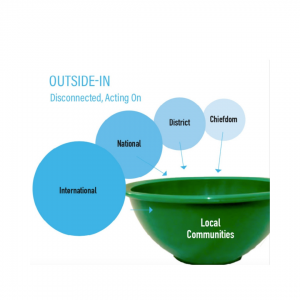
The role of the bowl within (the ‘insider’) is to draw together in honest conversation with peers about needs, goals, challenges, desires, even when that means having ‘frank talk’ about difficult things; to name and claim their own agenda, and to work togeth
er to achieve it.
The role of an external ‘bowl’ (the ‘outsider’) is to hold the space to see, invite and magnify the voice, leadership and capacity of the level within.”
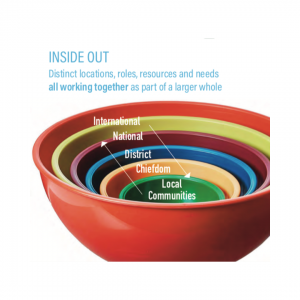
These two metaphors of mending the cup and nested systems can be adopted in many places. For example, in education, how do we shift to seeing a classroom at the center, with the quality and health of that experience being the focus, and other parts of the system supporting that? This view of nested systems is how nature works, and is a similar model emerging in businesses using self-organizing teams, in networked collaborations, and in regenerative design approaches.
For those ready to transcend paradigms of top-down/bottom up ways of working, the model and example of what has emerged in Sierra Leone is an inspiring example to learn from. They are living a new way:
“We are not trying to change the system as if peace and development is something ‘out there.’ We want to live into the system the way we think it should be.”– Libby Hoffman
Originally published at New Directives Collaborative on May 4, 2019.
Photo by NordWood Themes on Unsplash
Awareness Activities
A lot of research has been conducted lately to identify how awareness or mindfulness operates in our brain, the benefits of this mental state, and how we can spend more time in a mindful state. This research is of great value to Network Weavers. Two excellent books on the topic are Your Brain At Work by David Rock and Mindsight by Daniel Siegel. Also, consider exploring Researching Your Own Practice: The Discipline of Noticing.
Mindfulness occurs when we are able to step back from our present situation and reflect on what is occurring in a detached fashion. This state is extremely helpful to Network Weavers because it enables us to temporarily suspend our positions, emotions, or arguments and get a bigger and more nuanced sense of what is occurring. This opens the opportunity to act in new, refreshing ways: to appreciate the other, to listen more deeply, to notice potential.
The Awareness Activities in this handout can help us become more aware of what is happening around us.
[ap_spacing spacing_height="30px"]
A Network Connector Story
Sometimes a story can convey meaning better than a lecture. This week's free resource is a story from the early days of the Appalachian Center for Economic Network's (ACEnet) Kitchen Incubator describing how staff were network weaving small food producers in our region.
This focus on connecting people is important no matter what type of organization or network you are part of! We'd love to hear your network weaving stories.
A Network Connector Story
[ap_spacing spacing_height="20px"]
First, An Introduction [ap_spacing spacing_height="25px"]
For a long time, we've trained our eyes to see things with edges and boundaries: organizations, countries, selves. Things with edges and boundaries feel manageable and solid. [ap_spacing spacing_height="10px"]
But the world is changing at an alarming rate, and the old ways of seeing are not quite up to the vertigo of a fast-paced universe. We need new ways of understanding our world that take into account new possibilities. [ap_spacing spacing_height="10px"]
So, we start noticing networks –the relationships among people and the patterns those relationships create. Increasingly, we are realizing that it’s through networks that things get done. People go outside teams, organizations, and even countries to connect with those who can help them succeed. And, using social media, we can now collaborate and engage as easily with people around the globe as we can with people in our hometown. [ap_spacing spacing_height="10px"]
We soon start to notice that all networks aren’t the same. Certain patterns in networks, such as a hub and spoke, are great when you want control. But when you need lots of innovation and aren’t at all sure what will work, bringing together people from different networks who have different perspectives and backgrounds can generate transformative experimentation. [ap_spacing spacing_height="10px"]
But bringing together people effectively is not easy. It requires a whole set of new skills embodied in a new role we call a Network Weaver. A Network Weaver is someone who is aware of the networks around them and explicitly works to make them healthier (more inclusive, bridging divides). Network Weavers do this by connecting people strategically where there's potential for mutual benefit, helping people identify and join with others around their passions, and serving as a catalyst for self-organizing groups. [ap_spacing spacing_height="40px"]
A Tale of Network Connecting [ap_spacing spacing_height="20px"]
Nestled in the Appalachian foothills of southeastern Ohio is the ACEnet Food Ventures Center, a kitchen incubator where people can rent the use of equipment to process specialty food products. The goal of the Center is to help as many people as possible start local food businesses, even if they have very little money (as is the case for many people in this region). [ap_spacing spacing_height="10px"]
From the start, ACEnet staff knew they did not have the resources to provide entrepreneurs with the assistance they needed to be successful, so they developed another strategy. They spent much of their time strategically connecting entrepreneurs with each other. Here’s a typical scenario. [ap_spacing spacing_height="10px"]
It was a blue-sky October afternoon in 1995, and Bill –network weaver extraordinaire –was standing on the loading deck of the newly completed kitchen Incubator where start-up entrepreneurs came to make their specialty food products. Craig, from Frog Ranch Salsa, was loading cases of his award-winning product into his truck and grousing about the high cost of jars. [ap_spacing spacing_height="10px"]
Right then, another truck pulled up to the dock, and Betty – one of the owners of another salsa producer – hopped out and started unloading cases of empty jars that would be filled later that day. Bill immediately introduced Craig to Betty, encouraging them to compare notes about the quality of tomatoes that season and local bands that were playing in town that weekend. [ap_spacing spacing_height="10px"]
Network Weavers are continually making connections between people –but they are always connecting strategically. They point out commonalities that create a foundation for mutual benefit. They also help people figure out if they have the kind of personal and emotional connection that will enable them to do things together. [ap_spacing spacing_height="10px"]
The two were now laughing and joking, so Bill introduced an opportunity. They both used the same jar for their salsa. Couldn’t they order jars together and significantly lower the price? Craig and Betty both thought this idea had some real potential, so Bill helped them figure out how it might work. [ap_spacing spacing_height="10px"]
Network Weavers help people self-organize. They start with twosies –fairly simple activities that benefit both individuals. They coach rather than run the show. As a result, the two individuals are more thrivable: together they have freed up more money for their businesses and they now have a set of collaboration skills that can be used in many other situations. [ap_spacing spacing_height="10px"]
The first order worked out without a hitch. The next time Bill saw Betty, he suggested that they might want to include several other businesses who used the same size jars in the next order so they could lower the price even more. Soon the joint orders filled an 18-wheeler and the cost of the jars was one-third the cost they had paid when they ordered singly. Now they got it: they could come up with all kinds of ways that they could improve their business and the community, find others to join them and make something happen. In the next few years, the people involved in the jar orders became Network Weavers themselves and, with many others, organized two different festivals, a regional brand, a loan fund, a food policy council, an innovation fund and many more collaborations. [ap_spacing spacing_height="10px"]
Through modeling and coaching, Network Weaving encourages people to act their way into a new way of being. Network Weaving increases thrivability both for individuals and their communities as people gain the framework, skills, and processes they need to co-create wonderful communities. [ap_spacing spacing_height="10px"]
When people take on the role of Network Weaver, they take responsibility for working with others to create healthier networks. [ap_spacing spacing_height="20px"]
We encourage you to comment on this post so we can hear about your thoughts and experience.
[ap_spacing spacing_height="60px"]
Trust: Foundation of Effective Networks
This article is a chapter from the Network Weaver Handbook with several worksheets you can use with your networks, projects and organizations.
They go together nicely with the blog posts Trust in Networks is Fundamental to Social Change by Christine Capra and Trust in Networks by June Holley.
[ap_spacing spacing_height="20px"]
Network Weaver Mindset Posters
Ari Sahagun and Odin Zackman co-designed seven posters on Network Weaver Mindsets -- fresh with ecological metaphors. Feel free to use them in your work!
We'd love to hear your thoughts and comments below!
Here is an example of how they look printed and posted on a wall. These are from Freya Bradford of Rotary Charities of Traverse City.
